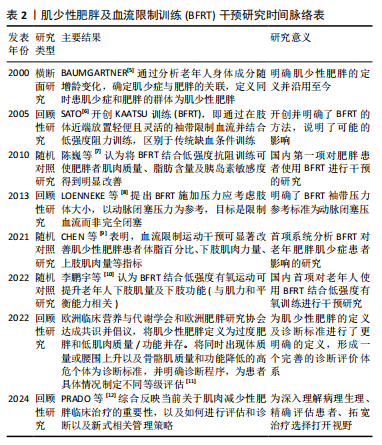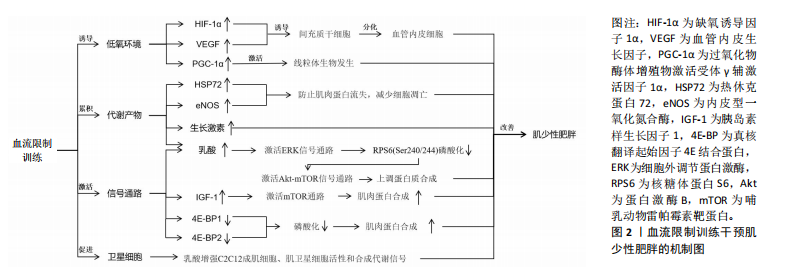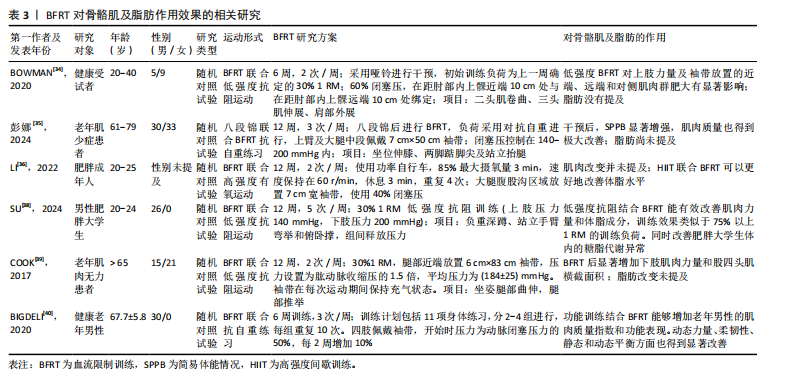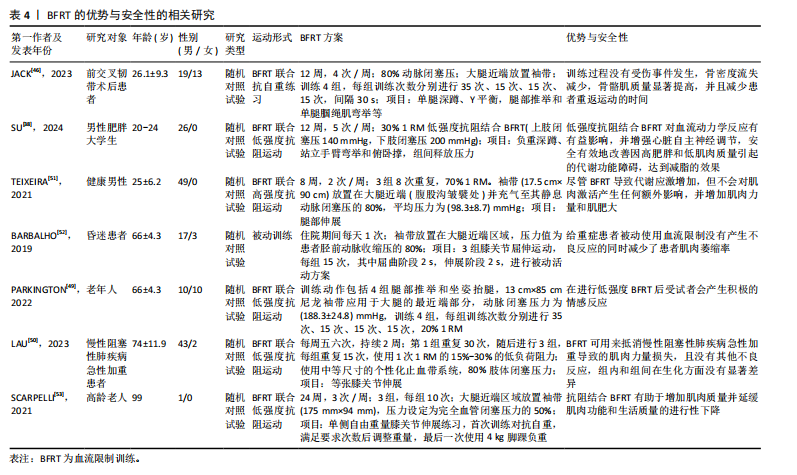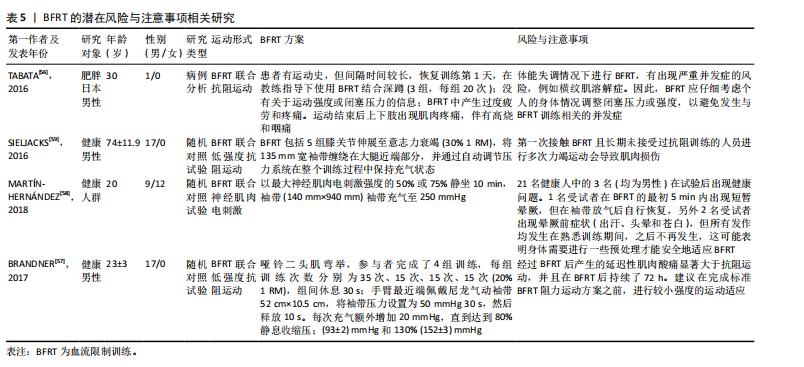[1] HSU KJ, LIAO CD, TSAI MW, et al. Effects of Exercise and Nutritional Intervention on Body Composition, Metabolic Health, and Physical Performance in Adults with Sarcopenic Obesity: A Meta-Analysis. Nutrients. 2019;11(9):2163.
[2] LIM ZX, GOH J. Effects of blood flow restriction (BFR) with resistance exercise on musculoskeletal health in older adults: a narrative review. Eur Rev Aging Phys Act. 2022;19(1):15.
[3] 唐小蝶,袁淑娟.血流限制训练在康复医学中的应用进展[J].中国体育科技, 2023,59(1):81-85.
[4] 魏佳,李博,杨威,等.血流限制训练的应用效果与作用机制[J].体育科学, 2019,39(4):71-80.
[5] BAUMGARTNER RN. Body composition in healthy aging. Ann N Y Acad Sci. 2000; 904:437-448.
[6] SATO Y. The history and future of KAATSU Training. Int J Kaatsu Train Res. 2005; 1(1):1-5.
[7] 陈巍,李娟,陈庆合,等.抗阻训练中运动肌血流限制对肥胖者体成分及胰岛素敏感度的影响[J].中国运动医学杂志,2010,29(6):646-649.
[8] LOENNEKE JP, FAHS CA, ROSSOW LM, et al. Blood flow restriction pressure recommendations: a tale of two cuffs. Front Physiol. 2013;4:249.
[9] CHEN N, HE X, ZHAO G, et al. Efficacy of low-load resistance training combined with blood flow restriction vs. high-load resistance training on sarcopenia among community-dwelling older Chinese people: study protocol for a 3-arm randomized controlled trial. Trials. 2021;22(1):518.
[10] 李鹏宇,何穗,韦兆颜,等.血流限制结合低强度有氧运动对老年人下肢肌量和功能的影响[J].循证护理,2022,8(16):2223-2227.
[11] DONINI LM, BUSETTO L, BISCHOFF SC, et al. Definition and diagnostic criteria for sarcopenic obesity: ESPEN and EASO consensus statement. Clin Nutr. 2022; 41(4):990-1000.
[12] PRADO CM, BATSIS JA, DONINI LM, et al. Sarcopenic obesity in older adults: a clinical overview. Nat Rev Endocrinol. 2024;20(5):261-277.
[13] KANG JS, KIM D, RHEE J, et al. Baf155 regulates skeletal muscle metabolism via HIF-1a signaling. PLoS Biol. 2023;21(7):e3002192.
[14] ZHANG H, HE H, CUI Y, et al. Regulatory effects of HIF-1α and HO-1 in hypoxia-induced proliferation of pulmonary arterial smooth muscle cells in yak. Cell Signal. 2021;87:110140.
[15] 赵丽,李杰.生命的低氧适应:2019年度诺贝尔生理学奖或医学奖成果解析[J].科技导报,2020,38(2):79-85.
[16] BARJASTE A, MIRZAEI B, RAHMANI-NIA F, et al. Concomitant aerobic- and hypertrophy-related skeletal muscle cell signaling following blood flow-restricted walking. Science & Sports. 2021;36(2):e51-e58.
[17] DENG H, TIAN X, SUN H, et al. Calpain-1 mediates vascular remodelling and fibrosis via HIF-1α in hypoxia-induced pulmonary hypertension. J Cell Mol Med. 2022;26(10):2819-2830.
[18] LI S, LI S, WANG L, et al. The Effect of Blood Flow Restriction Exercise on Angiogenesis-Related Factors in Skeletal Muscle Among Healthy Adults: A Systematic Review and Meta-Analysis. Front Physiol. 2022;13:814965.
[19] CHEN T, YE B, TAN J, et al. CD146+Mesenchymal stem cells treatment improves vascularization, muscle contraction and VEGF expression, and reduces apoptosis in rat ischemic hind limb. Biochem Pharmacol. 2021;190:114530.
[20] NASCIMENTO CM, INGLES M, SALVADOR-PASCUAL A, et al. Sarcopenia, frailty and their prevention by exercise. Free Radic Biol Med. 2019;132:42-49.
[21] OISHI Y, TSUKAMOTO H, YOKOKAWA T, et al. Mixed lactate and caffeine compound increases satellite cell activity and anabolic signals for muscle hypertrophy. J Appl Physiol (1985). 2015;118(6):742-749.
[22] GUNDERMANN DM, WALKER DK, REIDY PT, et al. Activation of mTORC1 signaling and protein synthesis in human muscle following blood flow restriction exercise is inhibited by rapamycin. Am J Physiol Endocrinol Metab. 2014;306(10): E1198-E1204.
[23] GOTO K, ISHII N, KIZUKA T, et al. The impact of metabolic stress on hormonal responses and muscular adaptations. Med Sci Sports Exerc. 2005;37(6):955-963.
[24] GUNDERMANN DM, FRY CS, DICKINSON JM, et al. Reactive hyperemia is not responsible for stimulating muscle protein synthesis following blood flow restriction exercise. J Appl Physiol (1985). 2012;112(9):1520-1528.
[25] 何穗,汪菊培,吴礼,等.血流限制训练的生理机制与应用进展[J].医学新知,2023,33(2):143-148.
[26] YOSHIKAWA M, MORIFUJI T, MATSUMOTO T, et al. Effects of combined treatment with blood flow restriction and low-current electrical stimulation on muscle hypertrophy in rats. J Appl Physiol (1985). 2019;127(5):1288-1296.
[27] MAY AK, RUSSELL AP, DELLA GATTA PA, et al. Muscle Adaptations to Heavy-Load and Blood Flow Restriction Resistance Training Methods. Front Physiol. 2022; 13:837697.
[28] NGUYEN LH, XU Y, MAHADEO T, et al. Expression of 4E-BP1 in juvenile mice alleviates mTOR-induced neuronal dysfunction and epilepsy. Brain. 2022;145(4): 1310-1325.
[29] PAPADOPOULOU SK. Sarcopenia: A Contemporary Health Problem among Older Adult Populations. Nutrients. 2020;12(5):1293.
[30] BJØRNSEN T, WERNBOM M, LØVSTAD A, et al. Delayed myonuclear addition, myofiber hypertrophy, and increases in strength with high-frequency low-load blood flow restricted training to volitional failure. J Appl Physiol (1985). 2019; 126(3):578-592.
[31] BJØRNSEN T, WERNBOM M, PAULSEN G, et al. Frequent blood flow restricted training not to failure and to failure induces similar gains in myonuclei and muscle mass. Scand J Med Sci Sports. 2021;31(7):1420-1439.
[32] SHI LL, ZHU KC, WANG HL. Characterization of myogenic regulatory factors, myod and myf5 from Megalobrama amblycephala and the effect of lipopolysaccharide on satellite cells in skeletal muscle. Gene. 2022;834:146608.
[33] KONG J, LI Z, ZHU L, et al. Comparison of blood flow restriction training and conventional resistance training for the improvement of sarcopenia in the older adults: A systematic review and meta-analysis. Sports Med Health Sci. 2022; 5(4):269-276.
[34] BOWMAN EN, ELSHAAR R, MILLIGAN H, et al. Upper-extremity blood flow restriction: the proximal, distal, and contralateral effects-a randomized controlled trial. J Shoulder Elbow Surg. 2020;29(6):1267-1274.
[35] 彭娜,苗笛,王红,等.八段锦联合血流限制训练对老年肌少症的应用效果研究[J].中华保健医学杂志,2024,26(3):332-335.
[36] LI S, GUO R, YU T, et al. Effect of High-Intensity Interval Training Combined with Blood Flow Restriction at Different Phases on Abdominal Visceral Fat among Obese Adults: A Randomized Controlled Trial. Int J Environ Res Public Health. 2022;19(19):11936.
[37] ALIZADEH PAHLAVANI H. Exercise Therapy for People With Sarcopenic Obesity: Myokines and Adipokines as Effective Actors. Front Endocrinol (Lausanne). 2022; 13:811751.
[38] SU Y, WANG F, WANG M, et al. Effects of blood flow restriction training on muscle fitness and cardiovascular risk of obese college students. Front Physiol. 2024;14:1252052.
[39] COOK SB, LAROCHE DP, VILLA MR, et al. Blood flow restricted resistance training in older adults at risk of mobility limitations. Exp Gerontol. 2017;99:138-145.
[40] BIGDELI S, DEHGHANIYAN MH, AMANI-SHALAMZARI S, et al. Functional training with blood occlusion influences muscle quality indices in older adults. Arch Gerontol Geriatr. 2020;90:104110.
[41] MARQUES A, QUEIRÓS C. Frailty, Sarcopenia and Falls. In: Hertz K, Santy-Tomlinson J, editors. Fragility Fracture Nursing: Holistic Care and Management of the Orthogeriatric Patient [Internet]. Cham (CH): Springer; 2018. Chapter 2.
[42] ZUO X, LI X, TANG K, et al. Sarcopenia and cardiovascular diseases: A systematic review and meta-analysis. J Cachexia Sarcopenia Muscle. 2023;14(3):1183-1198.
[43] BUNCHORNTAVAKUL C. Sarcopenia and Frailty in Cirrhosis: Assessment and Management. Med Clin North Am. 2023;107(3):589-604.
[44] SANZ-CÁNOVAS J, LÓPEZ-SAMPALO A, COBOS-PALACIOS L, et al. Management of Type 2 Diabetes Mellitus in Elderly Patients with Frailty and/or Sarcopenia. Int J Environ Res Public Health. 2022;19(14):8677.
[45] LIU C, LIU N, XIA Y, et al. Osteoporosis and sarcopenia-related traits: A bi-directional Mendelian randomization study. Front Endocrinol (Lausanne). 2022; 13:975647.
[46] JACK RA 2ND, LAMBERT BS, HEDT CA, et al. Blood Flow Restriction Therapy Preserves Lower Extremity Bone and Muscle Mass After ACL Reconstruction. Sports Health. 2023;15(3):361-371.
[47] VOLGA FERNANDES R, TRICOLI V, GARCIA SOARES A, et al. Low-Load Resistance Exercise with Blood Flow Restriction Increases Hypoxia-Induced Angiogenic Genes Expression. J Hum Kinet. 2022;84:82-91.
[48] NASCIMENTO DDC, PETRIZ B, OLIVEIRA SDC, et al. Effects of blood flow restriction exercise on hemostasis: a systematic review of randomized and non-randomized trials. Int J Gen Med. 2019;12:91-100.
[49] PARKINGTON T, MADEN-WILKINSON T, KLONIZAKIS M, et al. Comparative Perceptual, Affective, and Cardiovascular Responses between Resistance Exercise with and without Blood Flow Restriction in Older Adults. Int J Environ Res Public Health. 2022;19(23):16000.
[50] LAU CW, LEUNG SY, WAH SH, et al. Effect on muscle strength after blood flow restriction resistance exercise in early in-patient rehabilitation of post-chronic obstructive pulmonary disease acute exacerbation, a single blinded, randomized controlled study. Chron Respir Dis. 2023;20:14799731231211845.
[51] TEIXEIRA EL, DE SALLES PAINELLI V, SILVA-BATISTA C, et al. Blood Flow Restriction Does Not Attenuate Short-Term Detraining-Induced Muscle Size and Strength Losses After Resistance Training With Blood Flow Restriction. J Strength Cond Res. 2021;35(8):2082-2088.
[52] BARBALHO M, ROCHA AC, SEUS TL, et al. Addition of blood flow restriction to passive mobilization reduces the rate of muscle wasting in elderly patients in the intensive care unit: a within-patient randomized trial. Clin Rehabil. 2019; 33(2):233-240.
[53] SCARPELLI MC, BERGAMASCO JGA, ARRUDA EAB, et al. Resistance Training With Partial Blood Flow Restriction in a 99-Year-Old Individual: A Case Report. Front Sports Act Living. 2021;3:671764.
[54] TAKARADA Y, NAKAMURA Y, ARUGA S, et al. Rapid increase in plasma growth hormone after low-intensity resistance exercise with vascular occlusion. J Appl Physiol (1985). 2000;88(1):61-65.
[55] NASCIMENTO DDC, ROLNICK N, NETO IVS, et al. A Useful Blood Flow Restriction Training Risk Stratification for Exercise and Rehabilitation. Front Physiol. 2022;13: 808622.
[56] TABATA S, SUZUKI Y, AZUMA K, et al. Rhabdomyolysis After Performing Blood Flow Restriction Training: A Case Report. J Strength Cond Res. 2016;30(7):2064-2068.
[57] BRANDNER CR, WARMINGTON SA. Delayed Onset Muscle Soreness and Perceived Exertion After Blood Flow Restriction Exercise. J Strength Cond Res. 2017;31(11):3101-3108.
[58] MARTÍN-HERNÁNDEZ J, SANTOS-LOZANO A, FOSTER C, et al. Syncope Episodes and Blood Flow Restriction Training. Clin J Sport Med. 2018;28(6):e89-e91.
[59] SIELJACKS P, MATZON A, WERNBOM M, et al. Muscle damage and repeated bout effect following blood flow restricted exercise. Eur J Appl Physiol. 2016; 116(3):513-525.
[60] 苏艳红,杨孝磊,于海强.血流限制伴不同强度抗阻热身训练对肌肉激活及下肢肌力影响的差异[J].中国体育科技,2023,59(12):10-17.
[61] LIXANDRÃO ME, UGRINOWITSCH C, LAURENTINO G, et al. Effects of exercise intensity and occlusion pressure after 12 weeks of resistance training with blood-flow restriction. Eur J Appl Physiol. 2015;115(12):2471-2480.
[62] PATTERSON SD, HUGHES L, WARMINGTON S, et al. Blood Flow Restriction Exercise: Considerations of Methodology, Application, and Safety. Front Physiol. 2019;10:533.
[63] LOENNEKE JP, WILSON JM, MARÍN PJ, et al. Low intensity blood flow restriction training: a meta-analysis. Eur J Appl Physiol. 2012;112(5):1849-1859.
[64] CAHALIN LP, FORMIGA MF, ANDERSON B, et al. A call to action for blood flow restriction training in older adults with or susceptible to sarcopenia: A systematic review and meta-analysis. Front Physiol. 2022;13:924614.
[65] LETIERI RV, TEIXEIRA AM, FURTADO GE, et al. Effect of 16 weeks of resistance exercise and detraining comparing two methods of blood flow restriction in muscle strength of healthy older women: A randomized controlled trial. Exp Gerontol. 2018;114:78-86.
[66] CHANG H, YAN J, LU G, et al. Muscle strength adaptation between high-load resistance training versus low-load blood flow restriction training with different cuff pressure characteristics: a systematic review and meta-analysis. Front Physiol. 2023;14:1244292. |
